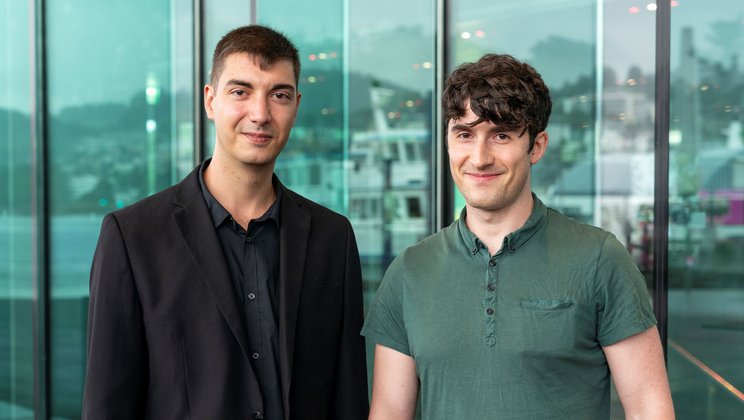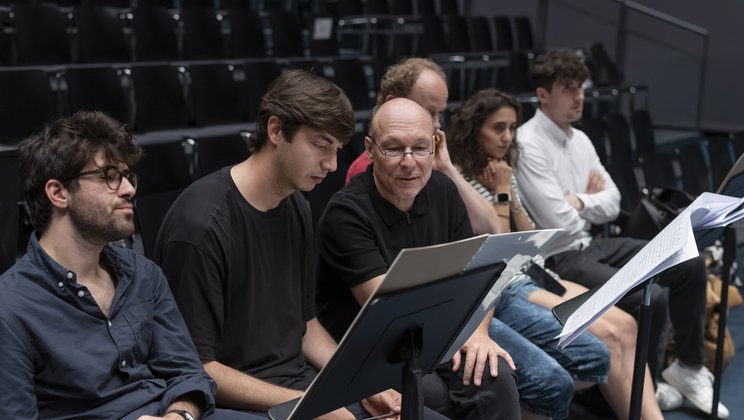Creating a new work
The “Roche Young Commissions” series was established for the first time in 2013 as an unique form of cooperation between Roche, Lucerne Festival, and the Lucerne Festival Academy. It gives two young composers the opportunity to write orchestral works. Within this context, the Spaniard Guillem Palomar and the German Jakob Raab have spent two years developing new orchestral pieces, which will now be premiered in summer 2025 and which we'll get to know here.
Smallest structural unit vs. overall form: Guillem Palomar on “Tessera”
“The title Tessera (a single mosaic piece or stone) references different sources of inspiration that have influenced the writing of this piece. The first one, and perhaps the most obvious, is mosaics themselves – ranging from Pompeian antiquity and Andalusian Islamic art to Gaudí’s trencadís, that mosaic technique one can so easily observe in my hometown, Barcelona. The fascination with mosaics (and particularly those in Islamic art) led further to an amateur interest in wallpaper theory and more complex forms of tessellation (such as those one can observe in M.C. Escher).
The second predominant source of inspiration was Richard Taruskin’s writings on Stravinsky (Stravinsky and the Russian Traditions, University of Californa Press, 1996), in which he refers to irreducible rhythmical or metrical units as ‘musical tesserae’ – Boulez calls them ‘cells’, a somewhat more widespread term (Notes of an Apprenticeship, New York, 1968) – which implies not only their belonging to a larger and intricate landscape but also their mobility within it.
It is a fundamental question to ask oneself as a composer: what is the relationship between the smallest structural unit and the overall form of a musical piece? Tessera (not unlike other pieces of mine) deals with that question and continues my research into form, syntax, and emotion in musical time. Nevertheless, Tessera breaks with other compositions of mine: internal structures are now more sumptuous than they used to be. Musical material is synthesised into musical motives, phrases, or formal layers that are hierarchically audible – ultimately, perhaps the only possible way in which complex or intricate relationships arise.”
“Inextricably linked to Britten’s opera”: Jakob Raab on “malo”
“The starting point of my piece malo is a small passage from Benjamin Britten’s opera The Turn of the Screw, in which the young Miles recites a mnemonic rhyme from his Latin lessons:
Malo: I would rather be
Malo: in an apple tree
Malo: than a naughty boy
Malo: in adversity
Listen to a recording from the 2011 Glyndebourne Festival here
Here, the different meanings of the word malo – depending on pronunciation (‘I would rather,’ ‘apple tree,’ and ‘bad’ or ‘naughty’) – are cleverly combined in a playful pun. A central part of both Britten’s opera and Henry James’s novella is their focus on Miles’ behavioral issues, his poor academic performance, and his nonconformity. Once a model student, dark forces appear to take over, leading to his expulsion and eventually his death.
The Turn of the Screw was one of the first operas I attended as a young person. I distincly remember being deeply moved by the fact that this naive children’s rhyme, seemingly insignificant, returns once more at the final and most dramatic moment of the opera, Miles’ death, this time sung not by him but at him, by his governess, holding his lifeless body. Just like the governess, the listener (and in this case, me), realizes in this very moment the twisted meaning behind Miles’ song, the line ‘than a naughty boy’ from the rhyme echoes at the end of the opera like a remorseful realization on the part of the governess.
Like every musician, I am constantly surrounded by music, and even while composing, I am haunted by musical earworms. Early on, I decided to incorporate these fragments of memory into my music – not as quotations, but as points of departure and sources of material. This allows me to approach the compositional process with a certain degree of detachment, as part of the material does not truly originate from me and thus I can engage with it in a more distanced manner.
The short aria from The Turn of the Screw was a fitting musical source for me, not only because of its meaning in the opera, but also because the harmony and melody of this stylized children’s song are exceptionally simple: parallel thirds and descending fifths. This makes it possible for me to break the piece down into its components and assimilate them into my own musical language.
Because program notes can significantly shape the listening experience – especially in the case of new music – I am often hesitant to provide explicit references to the original source of my material; I don’t want to work with quotations and their semantic baggage. In this case, however, I feel that my piece is inextricably linked to the content of Britten’s opera, both emotionally and musically.”
-
Sat 30.08.Lucerne Festival Academy 3Date and Venue
Sat 30.08. | 14.30 | KKL Luzern, Concert HallProgram
Palomar | Raab | AmmannRoche - Main Sponsor and Partner Lucerne Festival AcademySummer Festival 2025starting at CHF 30


